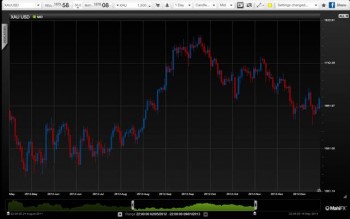Recent announcements from the US Federal Reserve implying a possible end to very lose monetary policy has created upside resistance for the gold price. However, growing desperation among policy makers to bring about sustained economic recovery is likely to be supportive for the yellow metal.
Last week the Fed’s FOMC minutes revealed that a number of its members thought it appropriate to slow or stop asset purchases by the end of 2013. That came as quite a shock to the gold market, which sold off in a knee-jerk reaction. The other black cloud for gold bulls is the Fed’s target to help bring the unemployment rate to below 6.5%, compared with 7.8% now without overly stimulating forward inflation expectations.
These announcements opened the possibility that quantitative easing is going to end quite soon. If this happened it would be a big set-back for gold, which would likely be sold off aggressively. Gold’s lofty valuation floats on a sea of monetary liquidity. But will the Fed be able to do that? Certainly, there have been some encouraging signs for the US economy. The crucial real estate market is stabilising and jobs are being created albeit at a slower pace than the authorities desire.
But the US economy remains vulnerable and sustained growth is far from assured. Events such as negotiations over the US debt ceiling, possible further eruptions of the Eurozone crisis and tensions in the Middle East are lurking growth killers. Another reason to pause over stopping the Fed’s QE programme is that it could lead to higher funding costs for businesses and households, many of which still have fragile finances. Also, does the US really want a strong USD? Rising exports have been a bright spot for the economy.
If bad news remains gold’s best friend over the long-term, consider that only late last year the IMF was warning that the risks of recession for advanced economies remain alarmingly high and that is true today. At the same time there is the prospect of monetary stimulus action from the European Central Bank to support peripheral Eurozone bond markets if they get into trouble. Previous actions by the ECB, often following big sell-offs, have generally been very positive for asset markets. The Bank of Japan is also likely to be very active this year prompted by Japan’s new government headed by Shinzo Abe and may raise its inflation target to 2% from 1% thereby giving it leeway to be much more aggressive.
Central banks are likely to remain very active this year and beyond as policy makers around the world are becoming increasingly desperate to stimulate economic growth. The arrival of Canadian central banker Mark Carney at the Bank of England in July is also likely to prove interesting. He has talked of targeting GDP growth rather than inflation (The Fed’s employment target is a nudge in that direction). If such notions catch on among central bankers, and could well do if leading economies remain tepid, then that would likely be a very bullish catalyst for gold.
But it is noticeable that the gold price has become somewhat schizophrenic sometimes reacting negatively and occasionally positively to bad news. In other words a market, which remains in a consolidation phase. However, if it is to take out that hallowed price level of $2,000, ongoing money creation by central banks is a key condition and for that to happen ongoing bad news on the economy is needed. But for the bulls to take control of this market it may require further tests of support, possibly down to the $1,550 level. If that holds that would be another bullish factor for the yellow metal.

